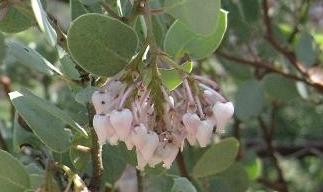Pajaro manzanita
(Arctostaphylos pajaroensis)

Description
Arctostaphylos pajaroensis is a species of manzanita known by the common name Pajaro manzanita. It is endemic to California, where it is known mainly from Monterey County. Historical occurrences have been noted in Santa Cruz County and far western San Benito County — these may no longer exist. Most of the extant populations are located in the hills south of the Pajaro River Valley. It is a member of the chaparral plant community. Arctostaphylos pajaroensis is an erect shrub growing at least 1 metre (3.3 ft) tall and known to exceed 4 metres (13 ft) in height. It has shreddy red or grayish bark with woolly hairs and long white bristles on its smaller twigs. The dense foliage is made up of gray-green, reddish-tinted leaves with smooth, toothed, or rolled edges. They are oval to somewhat triangular in shape and 2 to 4 centimeters long. The shrub flowers in the winter, bearing large loose inflorescences of pink to nearly white urn-shaped flowers. The fruit is a drupe about 7 millimeters wide. Arctostaphylos is a genus of plants comprising the manzanitas and bearberries. They are shrubs or small trees. There are about 60 species, of Arctostaphylos, ranging from ground-hugging arctic, coastal, and mountain species to small trees up to 6 m tall. Most are evergreen (one species deciduous), with small oval leaves 1–7 cm long, arranged spirally on the stems. The flowers are bell-shaped, white or pale pink, and borne in small clusters of 2–20 together; flowering is in the spring. The fruit are small berries, ripening in the summer or autumn. The berries of some species are edible. Arctostaphylos species are used as food plants by the larvae of some Lepidoptera species including Coleophora arctostaphyli (which feeds exclusively on A. uva-ursi) and Coleophora glaucella. Manzanitas, the bulk of Arctostaphylos species, are present in the chaparral biome of western North America, where they occur from southern British Columbia in Canada, Washington to California and New Mexico in the United States, and throughout much of northern and central Mexico. Three species, the bearberries, A. alpina (alpine bearberry), A. rubra (red bearberry) and A. uva-ursi (common bearberry), have adapted to arctic and subarctic climates, and have a circumpolar distribution in northern North America, Asia and Europe. An unusual association of manzanita occurs on Hood Mountain, in Sonoma County, California, where stands of pygmy forest dominated by Mendocino cypress are found.
Taxonomic tree:







